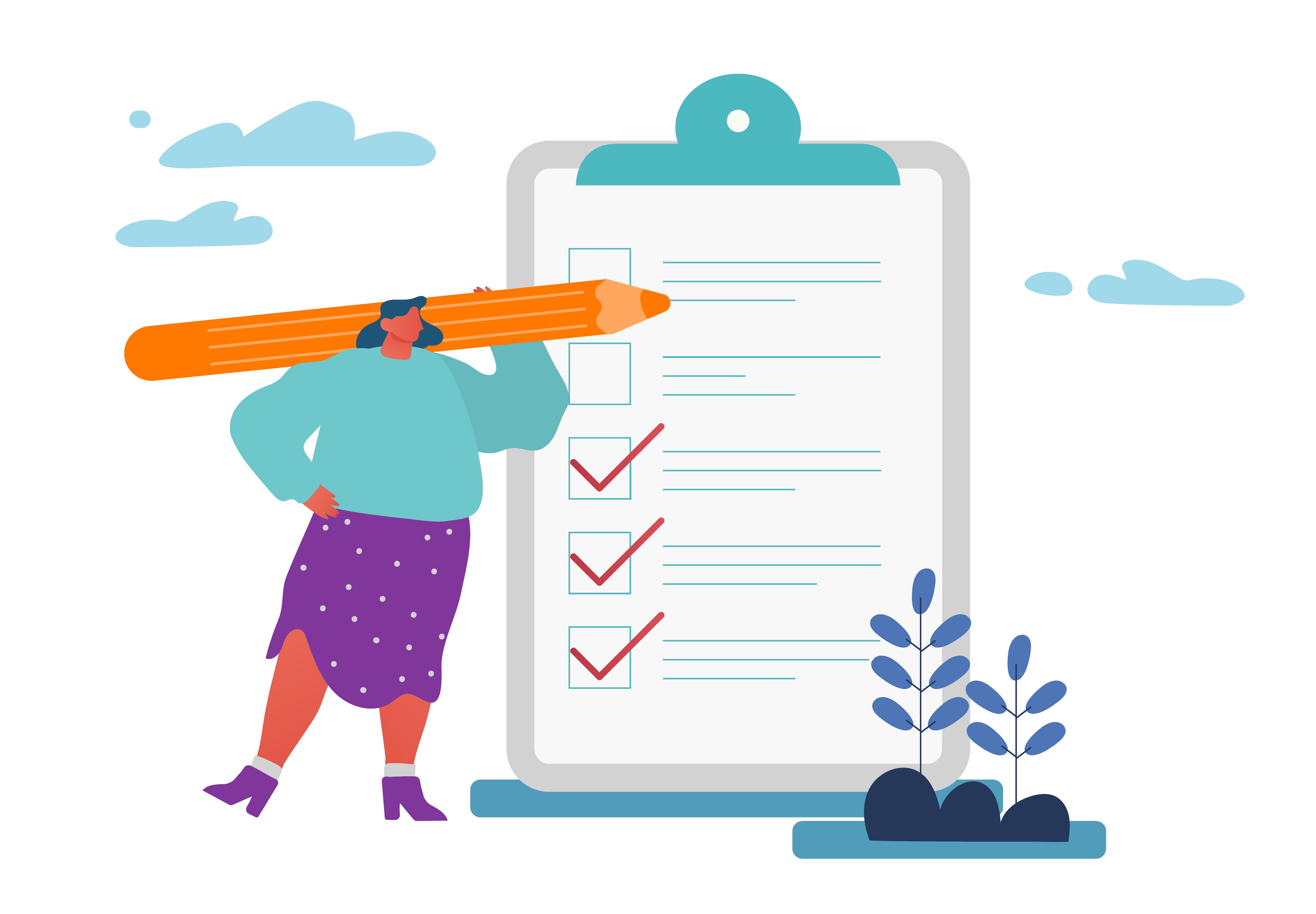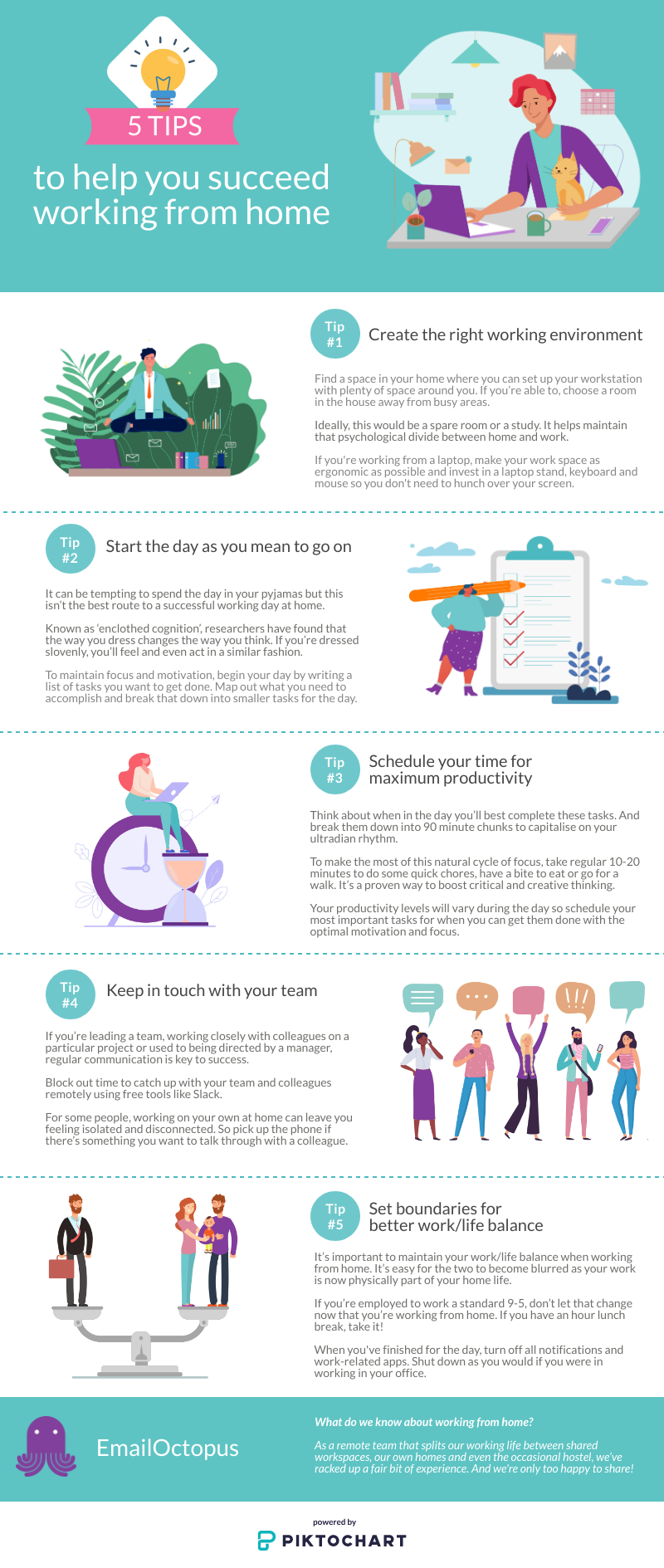After months of worldwide lockdowns, working from home is no longer the novelty it once was. We’ve all had to adapt to a new normal and find a WFH routine that suits us as individuals.
But as the boundaries between work life and home life become blurred and mental health continues to be a key concern during social isolation, it’s more important than ever to create a healthy and productive routine.
As a remote team that splits our working life between shared workspaces, our own homes and even the occasional hostel, we’ve racked up a fair bit of experience.
So if you’re still struggling to stay sane or hit your peak productivity level, here are our tips on how to successfully work from home.
Page Contents
Create the right environment
Before you sit down to thrash out your work, make sure you’re set up for success. If you’re used to working in an office with a spacious desk and a large monitor, you’ll find the working from home transition easier by replicating that set up.
Find a space in your home where you can set up your laptop or computer with room for a mouse and keyboard. And extra space for a notepad and pen (if you’re a bit old-school like me and still prefer to write notes as you work).
Osteopaths around the world must despair at the postural damage caused by hunching over laptops all day. It does you no good. So if you’re working from home with a laptop, make your work space as ergonomic as possible (as your office space should be).
Invest in a laptop stand, keyboard and mouse. They’re not too expensive. And you could always ask your company to reimburse you for the expense if they’ve asked you to work from home due to Coronavirus.
I’ve used a few different laptop stands and can recommend this NEXSTAND laptop stand as it gives you the right height, positioning your laptop screen at eye level. No more dipping your head to see your screen!

Find somewhere distraction-free
If you’re able to, find a room in the house away from busy areas. If you’re home alone, great! You can take your pick.
But if you’ve got family or housemates milling about, you’ll need somewhere you can close the door to noise and commotion. Ideally, this would be a spare room or a study. It helps maintain that psychological divide between home and work.
If your bedroom or living room are the only options, do what you can with what you’ve got. Clear the dining table or breakfast bar and claim it as your working space for the day.
And whatever you do, don’t even think of working in bed. It’s ultimately too distracting as you try to find the best position to balance your laptop. Or have to deal with numb legs every 10 minutes. It’s also far from ergonomic.
Start as you mean to go on
It’s important to start your working day at home as you would if you were going into the office.
Rule number one – get dressed! It can be tempting to spend the day in your pyjamas or even your gym gear if you’re squeezing in a workout during your normal 9 to 5. But this isn’t the best route to a successful working day at home.
Known as ‘enclothed cognition’, researchers have found that the way you dress changes the way you think. If you’re dressed slovenly, you’ll feel and possibly even act in a similar fashion.
If you’re used to working in smart attire or a uniform at work, you don’t need to stick to that same gear at home. But it’s definitely a good idea to put some effort into your appearance so you can approach your work with the same seriousness as you would at the office.

Write a daily to-do list
When working from home, it’s possible the lack of formal structure can result in a loss of focus and motivation. Especially if you’re used to starting the day with a team briefing.
To avoid this, begin your day by writing a list of tasks you want to get done. Map out what you need to accomplish and break that down into smaller tasks for the day ahead. You could use a good old-fashioned pen and paper combo or a free online productivity tool like Todoist.
Schedule your day
Once you know what you need to get done, think about how and when you’ll complete these tasks. And break them down into 90 minute chunks.
Why 90 minutes? Because various studies have found that we work more effectively in 90 minute spurts due to a clock-like system in our bodies known as the ultradian rhythm.
To make the most of this natural cycle of focus, don’t forget to include breaks. Take 10-20 minutes after each 90 minute spurt to do some quick chores, have a bite to eat or drink. Or even better, go for a walk. It’s a proven way to boost critical and creative thinking.
And an added bonus is that at home, you can do all this without fear of being judged by colleagues that you’re not chained to your desk for the full 8 hours of the working day.
Tune into your productivity levels
Now that you’re working from home, you’ll have the mental space and freedom to figure out when you’re most productive.
Your productivity levels will vary during the day. You might be most motivated first thing in the morning. Or it might be later in the day when you’ve had a proper chance to shake loose the previous night’s sleep.
And sure, there may still be scheduled remote meetings and your boss may still want you to stick to a rigid 9-5 working day. But you’ll have the newfound flexibility to tackle your most important tasks when it best suits you. And without being distracted by office chit-chat or interruptions from colleagues needing you for a “quick minute”.
Use this to your advantage and schedule your most important tasks for when you can get them done with the most motivation and focus. If you’re not sure when that is, start by ‘eating the frog’.
Basically, you want to get your least favourite or hardest task finished first thing in the morning. This then gives you the rest of the day to bask in the glory of knowing it’s out of the way and you can move on to tasks you actually enjoy.
Stick to a healthy routine
With the extra hours you’ll find in your day from no longer having to commute, it can be tempting to fall into less-than healthy habits. And staying up late is one of the first bad habits that can develop when you transition from the office to working from home.
Whether it’s the lure of your latest Netflix obsession or the pull of social media updates, you may find yourself going to bed much later than you normally would. But it’s important to stick to a good nightly routine and get the sleep you need for a productive day’s work.
Irregular sleep patterns have been shown to increase the risk of metabolic disorders while sleep deprivation can lead to a host of health problems.
And in the time of a global health pandemic, getting at least seven hours of sleep each night is one of the best things you can do for your immune system.

Keep in touch
If you’re leading a team, working closely with colleagues on a particular project or used to being directed by a manager, regular communication is key to success.
To help make a smoother transition from office life to working from home, block out time to catch up with your team and colleagues remotely. Free tools like Slack are perfect for this. You can easily set up video calls and send instant messages.
It’s also important to note that for some people, working on your own at home can leave you feeling isolated and disconnected. Especially if you thrive off the social atmosphere of an office and the direct access to feedback. Or just the lols with colleagues that have become friends.
Good online communication can help negate these feelings. Pick up the phone if there’s something you want to talk through with a colleague and set up a #random channel to share memes and GIFs to help you through the day. Even if it does mean laughing out loud alone.
Set boundaries
It’s important to maintain your work/life balance when working from home. It’s easy for the two to become blurred as your work is now physically part of your home life. That computer screen is now a constant source of work invasion in your personal space.
It manifests in the urge to check your inbox one more time because it’s there and easy to do. Or in the impulse to chip away at a few small, quick tasks as you’re already at home with nothing better to do.
But that’s why it’s vital to set boundaries for yourself. If you’re employed to work a standard 9-5, don’t let that change now that you’re working from home. If you have an hour lunch break, take it!
Office workers are often surprised to hear that it’s very easy to work longer hours when working from home.
It might be because you enter a state of flow more easily and more often at home. And when you do, it’s easy to forget to take that full hour’s lunch break. Or wrap up work at 5pm.
Or it might be because it’s so easy to stay online and connected with your work now that it’s all set up in your living room, the kitchen or your bedroom.
Whatever the reason, avoid it by prioritising your life outside of work. Use the lunch break to tackle personal chores. Finish on time so you can exercise or socialise with friends.
Resist the ‘work from home’ guilt
Yes, it’s a real thing.
The stigma that you contribute less to your job when you’re working from home instead of being physically present in office affects almost half of employees.
In a study carried out by LogMeIn, 46% of respondents agreed that they felt under pressure to demonstrate that they’re actually working, whether that meant sending more emails than necessary, answering messages as soon as they arrive or working longer hours.
Overcome this by:
- Sharing your daily schedule with your colleagues – let them know when you’ll be checking and responding to emails, or online for instant messages.
- Using the status functions on your digital communication channels to inform others when you’re online, at lunch or busy working on a task.
- Holding daily stand-ups so the whole team knows who’s doing what each day – make your working day as transparent as you can to tackle any misperceptions.

And lastly, enjoy the opportunity!
Working from home is hugely enjoyable for many people. So if Coronavirus has you out of the office and in social isolation, make the most of it.
Use the time you would have spent commuting to the office to invest in a hobby. Or to exercise. Or to finally clear through boring life admin.
Whether it’s for a few days or a couple of weeks, take this opportunity to boost your productivity and maximise your extra free time.
Download our free infographic with our top 5 tips on how to succeed working from home

Or if you work from home and have tips to share, let us know in the comments below.


No Comments
Leave a comment Cancel